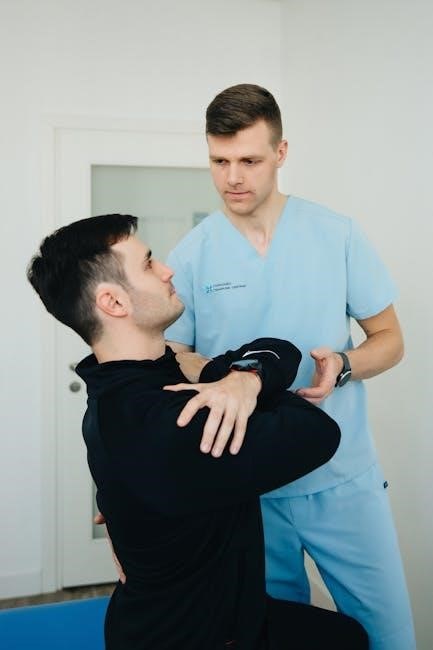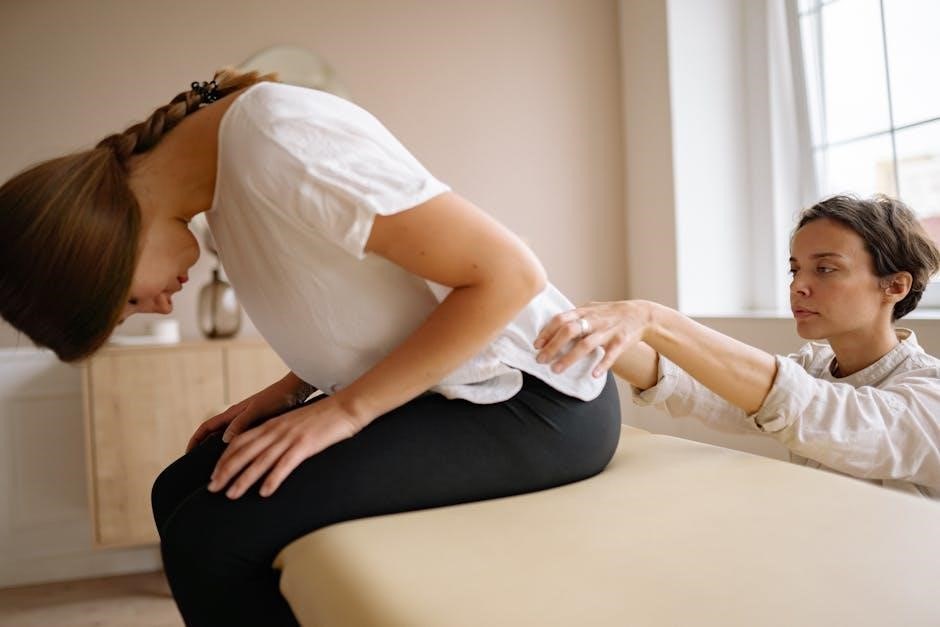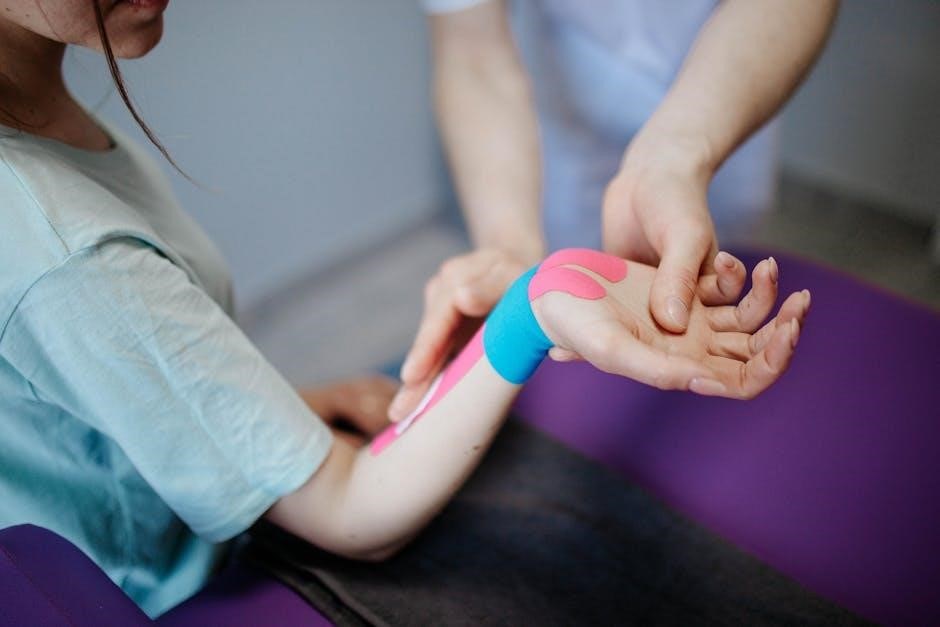Tibia fracture physiotherapy exercises are crucial for recovery, involving
- specific movements
and stretches to improve mobility and strength, as outlined in various rehabilitation guides and medical resources online always.
Importance of Rehabilitation After Tibia Fracture
Rehabilitation after a tibia fracture is essential for restoring function and mobility to the affected limb. A well-structured rehabilitation program can help prevent complications and promote a speedy recovery. According to various medical resources, rehabilitation should begin as soon as possible after the injury, with the goal of improving range of motion, strength, and overall function. This can be achieved through a combination of physical therapy exercises, occupational therapy, and other interventions. The importance of rehabilitation cannot be overstated, as it plays a critical role in helping patients regain their independence and quality of life. By following a rehabilitation program, patients can reduce their risk of long-term disability and improve their overall outcomes. With the help of a qualified healthcare professional, patients can develop a personalized rehabilitation plan that meets their unique needs and goals, using resources such as tibia fracture physiotherapy exercises pdf.

Understanding the Risks and Complications
Risks include infection, nerve damage, and compartment syndrome complications always.
Complex Regional Pain Syndrome and Its Symptoms
Complex regional pain syndrome is a condition that can occur after a tibia fracture, characterized by sensitivity to light touch, cold insensitivity, and color changes in the skin. Other symptoms include decreased range of motion and excessive pain. This condition can be challenging to treat, and early diagnosis is crucial for effective management. A certified physical or occupational therapist can help develop a treatment plan to alleviate symptoms and improve mobility. The primary goal of treatment is to reduce pain and inflammation, improve range of motion, and restore functional abilities. Treatment may involve a combination of physical therapy, medication, and lifestyle modifications. It is essential to work with a healthcare professional to develop a personalized treatment plan. With proper treatment, individuals with complex regional pain syndrome can experience significant improvement in their symptoms and quality of life, and return to their normal activities, including exercise and physical therapy.

Post-Surgical Rehabilitation Protocols
Protocols involve specific guidelines and exercises to ensure proper healing and recovery after tibia fracture surgery always and quickly.
Guidelines for Physical and Occupational Therapy
Guidelines for physical and occupational therapy are essential for tibia fracture rehabilitation, as they provide a framework for therapists to follow. These guidelines are typically developed by healthcare professionals and are based on the latest research and evidence. They outline the specific exercises and interventions that should be used to promote healing and restore function. The guidelines may include information on the frequency and duration of therapy sessions, as well as the specific exercises and activities that should be performed. They may also provide guidance on how to progress the exercises and activities as the patient’s condition improves. By following these guidelines, therapists can help patients with tibia fractures to achieve the best possible outcomes and regain their independence. The guidelines are often tailored to meet the individual needs of each patient, and may be modified as needed to ensure optimal results.
Initial Treatment and Management
Ice and elevation are used to reduce pain and swelling, as outlined in medical guides for initial treatment always.
Pain Reduction and Inflammation Management Techniques
Pain reduction and inflammation management are crucial aspects of tibia fracture recovery, involving various techniques such as ice therapy, compression, and elevation, as outlined in rehabilitation guides. These methods help reduce swelling and alleviate pain, promoting a conducive environment for healing. Ice therapy, in particular, is effective in reducing inflammation, and its application is usually recommended for 15-20 minutes, several times a day. Elevation of the affected limb above the level of the heart also helps reduce swelling by promoting blood flow. Additionally, compression bandages or stockings may be used to provide support and reduce swelling. By incorporating these techniques into the treatment plan, patients can effectively manage pain and inflammation, facilitating a smoother recovery process and reducing the risk of complications. This is essential for successful rehabilitation, enabling patients to regain mobility and strength in the affected area.
Exercise Examples for Tibia Fracture Rehabilitation
Specific exercises like straight leg raises and
- knee bends
are essential for rehabilitation always.
Passive and Active Knee Range of Motion Exercises
Passive and active knee range of motion exercises are crucial for rehabilitation, involving specific movements to improve mobility and strength. These exercises can be performed with the assistance of a physical therapist or independently, using equipment such as a continuous passive motion machine. The goal of these exercises is to increase knee flexion and extension, reducing stiffness and improving overall function. A typical exercise routine may include passive knee extension, where the therapist slowly straightens the knee, and active knee flexion, where the patient bends their knee using their own muscle strength. Additionally, exercises such as
- knee slides
and
- heel slides
can be used to improve range of motion and reduce pain. Regular practice of these exercises can help patients regain knee mobility and strength, allowing them to return to their normal activities. By incorporating these exercises into their rehabilitation routine, patients can improve their overall recovery outcomes.

Progressing to Weight-Bearing and Strengthening Exercises
Patients progress to weight-bearing exercises using crutches and strengthening exercises to improve muscle function and mobility always slowly.
Gait Training and Multi-Plane Open Kinetic Chain Exercises
Gait training is an essential component of rehabilitation, focusing on restoring normal walking patterns and improving balance and coordination. This involves practicing walking on different surfaces, such as flat ground, stairs, and inclined planes, using various assistive devices like canes or crutches. Multi-plane open kinetic chain exercises are also crucial, targeting specific muscle groups to enhance strength, flexibility, and range of motion. These exercises include straight leg raises, leg presses, and knee extensions, which can be modified to accommodate individual patient needs and abilities. By incorporating gait training and multi-plane exercises into the rehabilitation program, patients can achieve optimal functional outcomes and return to their daily activities with confidence and independence, as outlined in various
- rehabilitation protocols
and medical resources online. Regular practice and progression of these exercises are vital for successful recovery.

